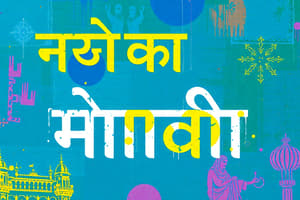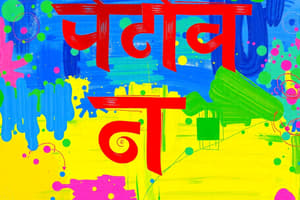Podcast
Questions and Answers
Which of the following best describes the relationship between Prakrit and Hindi?
Which of the following best describes the relationship between Prakrit and Hindi?
- Prakrit and Hindi developed independently with no mutual influence.
- Prakrit languages evolved into Apabhramsa, from which early forms of Hindi developed. (correct)
- Prakrit is a modern dialect of Hindi used primarily in rural regions.
- Hindi directly gave rise to Prakrit through a process of linguistic simplification.
What was the primary influence in the divergence of Hindavi into Hindi and Urdu?
What was the primary influence in the divergence of Hindavi into Hindi and Urdu?
- Governmental policies enforcing distinct grammatical structures in each language.
- The preference for vocabulary, with Hindi drawing from Sanskrit and Urdu from Persian and Arabic. (correct)
- The choice of script with Hindi adopting the Perso-Arabic script and Urdu using Devanagari.
- Geographical separation of speakers leading to dialectal variations.
What role did the British Raj play in the development of Modern Standard Hindi?
What role did the British Raj play in the development of Modern Standard Hindi?
- They had no involvement in the development of Hindi, focusing solely on economic and political matters.
- They initiated the standardization process of Modern Standard Hindi, promoting its use as an official language and in education. (correct)
- They promoted Urdu over Hindi, leading to a decline in Hindi's usage during their rule.
- They discouraged its use in favor of promoting English as the sole language of administration and education.
Which of the following is NOT a characteristic of the Devanagari script?
Which of the following is NOT a characteristic of the Devanagari script?
What is a key feature of Hindi grammar related to word order?
What is a key feature of Hindi grammar related to word order?
How does Modern Standard Hindi differ from Hindavi?
How does Modern Standard Hindi differ from Hindavi?
Which of the following is a characteristic of Hindi as an inflected language?
Which of the following is a characteristic of Hindi as an inflected language?
Amir Khusrau, a historical figure, is best known for his contributions to which aspect of Hindi language development?
Amir Khusrau, a historical figure, is best known for his contributions to which aspect of Hindi language development?
Which of the following statements accurately describes the writing system of Devanagari?
Which of the following statements accurately describes the writing system of Devanagari?
Which group of states constitutes the primary region known as the 'Hindi Belt'?
Which group of states constitutes the primary region known as the 'Hindi Belt'?
According to the Indian Constitution, what is the official status of Hindi?
According to the Indian Constitution, what is the official status of Hindi?
How do regional dialects of Hindi primarily differ from Modern Standard Hindi?
How do regional dialects of Hindi primarily differ from Modern Standard Hindi?
If a formal document in Hindi contains a high proportion of 'tatsam' words, what does this indicate about the vocabulary used?
If a formal document in Hindi contains a high proportion of 'tatsam' words, what does this indicate about the vocabulary used?
What is the significance of Hindustani in the context of Hindi and Urdu?
What is the significance of Hindustani in the context of Hindi and Urdu?
In what way has Bollywood influenced the Hindi language?
In what way has Bollywood influenced the Hindi language?
Which of the following is LEAST likely to be a direct benefit of learning Hindi?
Which of the following is LEAST likely to be a direct benefit of learning Hindi?
How might the vocabulary used in a Hindi news report about scientific research differ from the vocabulary used in a casual conversation between friends?
How might the vocabulary used in a Hindi news report about scientific research differ from the vocabulary used in a casual conversation between friends?
Premchand, Jaishankar Prasad, and Mahadevi Varma are most known for their contributions to which field?
Premchand, Jaishankar Prasad, and Mahadevi Varma are most known for their contributions to which field?
Flashcards
What is Hindi?
What is Hindi?
An Indo-Aryan language, an official language of India, and a lingua franca of the Hindi belt.
What are Prakrit languages?
What are Prakrit languages?
Ancient Indian languages from which Hindi's roots originate.
What is Apabhramsa?
What is Apabhramsa?
A later form of Prakrit that emerged after the 7th century AD and from which early forms of Hindi developed.
What is Khariboli?
What is Khariboli?
Signup and view all the flashcards
What is Hindavi/Dehlavi?
What is Hindavi/Dehlavi?
Signup and view all the flashcards
What is Modern Standard Hindi?
What is Modern Standard Hindi?
Signup and view all the flashcards
What is Abugida script?
What is Abugida script?
Signup and view all the flashcards
What does SOV mean?
What does SOV mean?
Signup and view all the flashcards
Devanagari Diacritics
Devanagari Diacritics
Signup and view all the flashcards
The Hindi Belt
The Hindi Belt
Signup and view all the flashcards
Official Status of Hindi
Official Status of Hindi
Signup and view all the flashcards
Tatsam Words
Tatsam Words
Signup and view all the flashcards
Tadbhav Words
Tadbhav Words
Signup and view all the flashcards
Hindustani
Hindustani
Signup and view all the flashcards
Bollywood
Bollywood
Signup and view all the flashcards
Hindi Speaking countries
Hindi Speaking countries
Signup and view all the flashcards
Khariboli
Khariboli
Signup and view all the flashcards
Article 343
Article 343
Signup and view all the flashcards
Study Notes
- Hindi is a prominent Indo-Aryan language primarily spoken in India.
- It holds the position of the official language for the Union government of India.
- Functions as an additional official language of India, coexisting with English.
- Serves as a lingua franca within the Hindi belt languages.
- Geographically spoken across northern, central, eastern, and western regions of India.
- Derives from ancient Prakrit languages.
- Evolved from the Apabhramsa form of Prakrit, which emerged after the 7th century AD.
- Modern Standard Hindi is anchored in the Khariboli dialect.
- Khariboli is the dialect spoken in the Delhi region.
History and Evolution
- Hindi's development is marked by distinct stages of linguistic evolution.
- Old Indo-Aryan led to Middle Indo-Aryan languages like Prakrits and Pali.
- These Middle Indo-Aryan languages paved the way for Apabhramsa.
- Early Hindi forms developed from Apabhramsa.
- Hindavi, alternatively known as Dehlavi, is the historical precursor to modern Hindi.
- Hindavi exhibits significant influence from Persian, Arabic, and Turkic languages.
- Amir Khusrau (1253–1325), an early and celebrated poet, composed works in Hindavi.
- Hindavi later branched into Hindi and Urdu.
- Hindi adopted तत्सम (tatsam) words from Sanskrit.
- Urdu integrated more Persian and Arabic vocabulary.
Modern Standard Hindi
- Modern Standard Hindi represents the standardized and Sanskritized form of Hindustani
- The standardization of Hindi occurred in the 19th century with backing from the British Raj
- Modern Standard Hindi is written using the Devanagari script
- Promoted as an official language and medium of education.
- Its vocabulary is mainly derived from Sanskrit and Prakrit.
- Modern Standard Hindi is distinct from Hindi dialects and Urdu.
Linguistic Features
- Hindi is classified as an Indo-European language
- It belongs to the Indo-Aryan branch
- Its grammar shares similarities with other Indo-Aryan languages
- Follows an SOV (subject–object–verb) sentence structure
- Employs postpositions instead of prepositions
- Exhibits relatively flexible word order for stylistic purposes
- Is an inflected language
- Nouns inflect according to gender, number, and case
- Verbs inflect based on tense, aspect, mood, gender, number, and person
- Distinguishes between direct and oblique cases
- Case marking is typically indicated using postpositions
Devanagari Script
- Hindi is written in the Devanagari script
- Devanagari is an abugida script
- Each consonant possesses an inherent vowel sound
- Vowels differing from the inherent one are denoted using diacritics
- Devanagari is written from left to right
- Includes characters for consonants, vowels, and numerals
- Also used for writing Sanskrit, Marathi, and Nepali
Geographical Distribution
- Hindi is commonly spoken across India
- Predominant in the Hindi Belt
- The Hindi Belt includes Uttar Pradesh, Madhya Pradesh, Bihar, Haryana, Rajasthan, Himachal Pradesh, Uttarakhand, Chhattisgarh, and Jharkhand
- Spoken in major cities, including Delhi and Mumbai
- Spoken by diaspora communities in the United States, United Kingdom, Canada, South Africa, Mauritius, and Fiji
Official Status
- One of the two official languages of the Union government of India
- English is the other official language
- Article 343 of the Indian Constitution designates Hindi as the official language of the Union
- Official script is Devanagari
- An additional official language in some Indian states
- The Central Hindi Directorate promotes Hindi
- The Commission for Scientific and Technical Terminology develops technical terminology in Hindi
Dialects and Variations
- Features several regional dialects and variations
- May exhibit significant differences in vocabulary and pronunciation
- Prominent dialects include Awadhi, Braj Bhasha, Bhojpuri, Bundeli, Bagheli, and Chhattisgarhi
- Serves as the base for Modern Standard Hindi
Vocabulary
- Influenced by Sanskrit, Prakrit, Persian, Arabic, and English
- तत्सम (tatsam) words are Sanskrit loanwords that have been adopted directly into Hindi
- तद्भव (tadbhava) words are derived from Prakrit
- Includes loanwords from Persian, Arabic, and English
- The proportion of words from each source varies depending on context and register
- Formal and technical writing contains more Sanskrit-derived vocabulary
- Everyday speech incorporates words from various sources
Literature
- Features a rich literary tradition encompassing poetry, prose, drama, and fiction
- Early Hindi literature includes works by poets like Kabir, Tulsidas, and Surdas
- Modern Hindi literature has been shaped by socio-political movements
- Prominent modern writers include Premchand, Jaishankar Prasad, and Mahadevi Varma
Influence of Hindi
- Has influenced other languages and cultures
- Hindustani, a blend of Hindi and Urdu, has served as a common language in the Indian subcontinent
- Bollywood, the Hindi-language film industry, has popularized Hindi
- Employed in music, television, and digital media
- Used in education and government administration
Learning Hindi
- Taught in schools across India
- Many universities offer Hindi language and literature programs
- Online resources and language learning apps are available
- Knowledge of Hindi is beneficial for those interested in Indian culture, business, and tourism
- Learning Hindi provides insights into related languages like Urdu, Nepali, and Punjabi
Studying That Suits You
Use AI to generate personalized quizzes and flashcards to suit your learning preferences.
Description
Explore the origins and development of the Hindi language, an Indo-Aryan language and official language of India. Trace its evolution through Prakrit and Apabhramsa to modern Hindi based on the Khariboli dialect. Learn about its historical linguistic stages.




